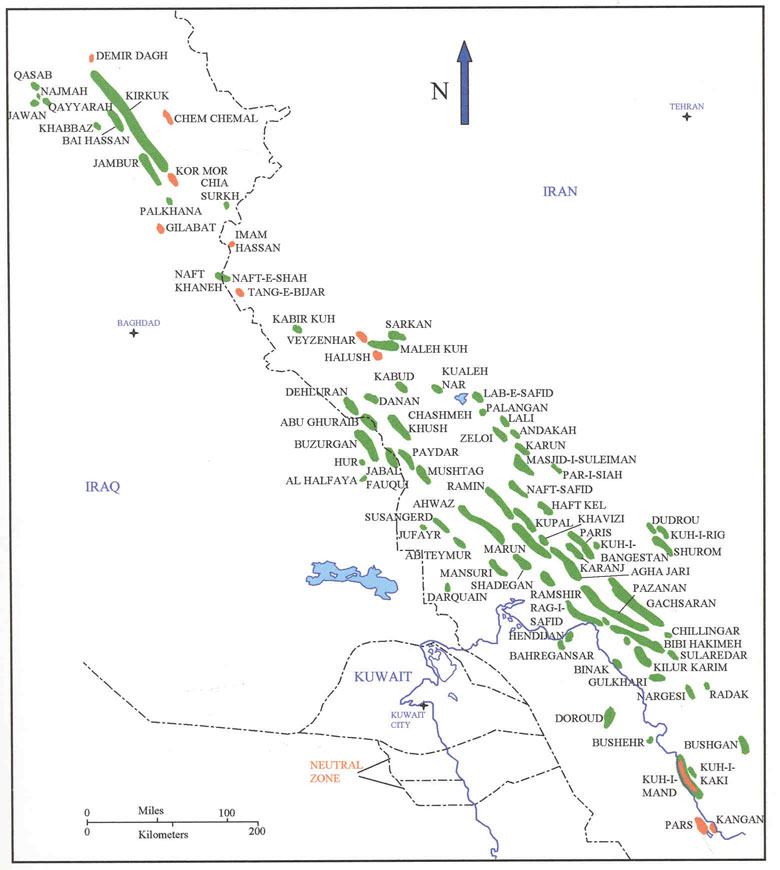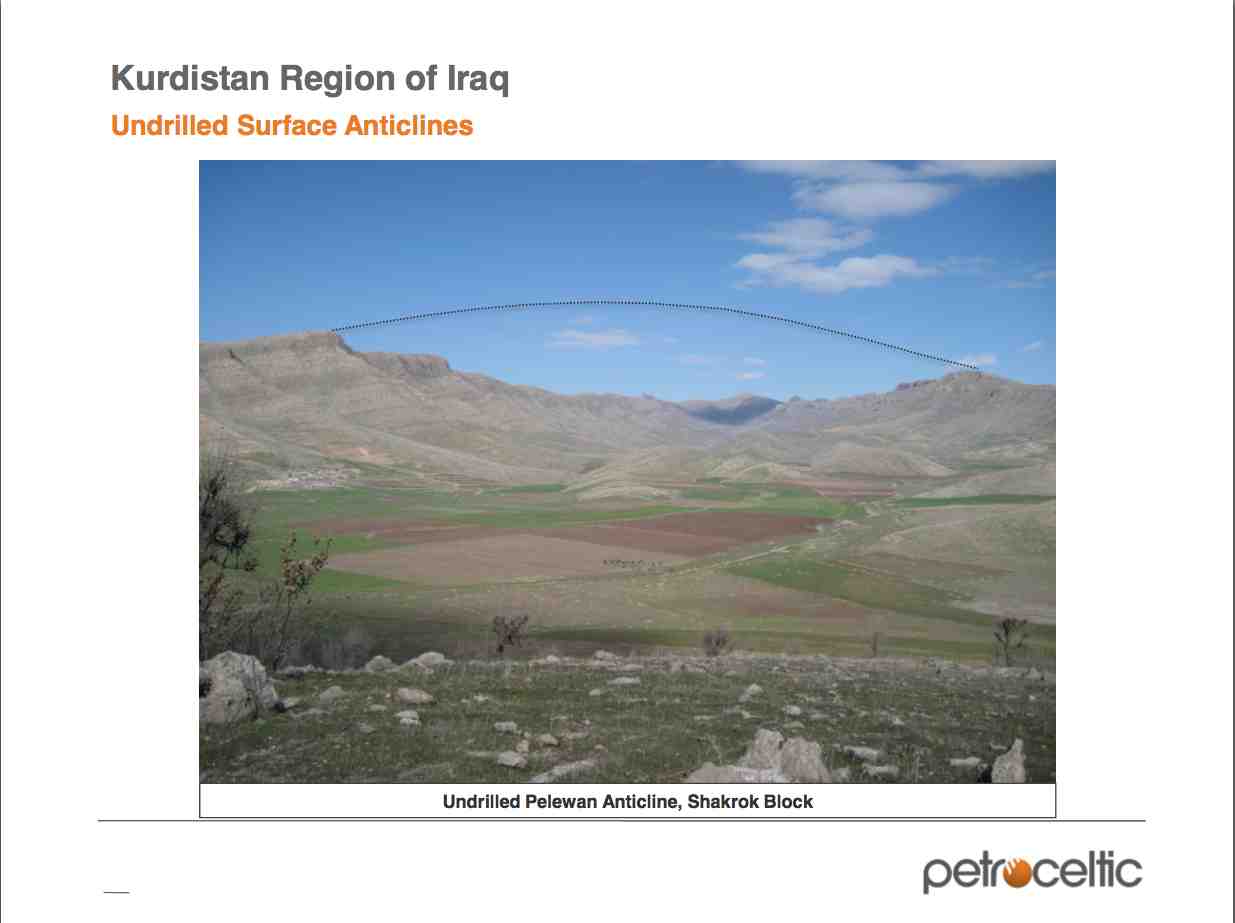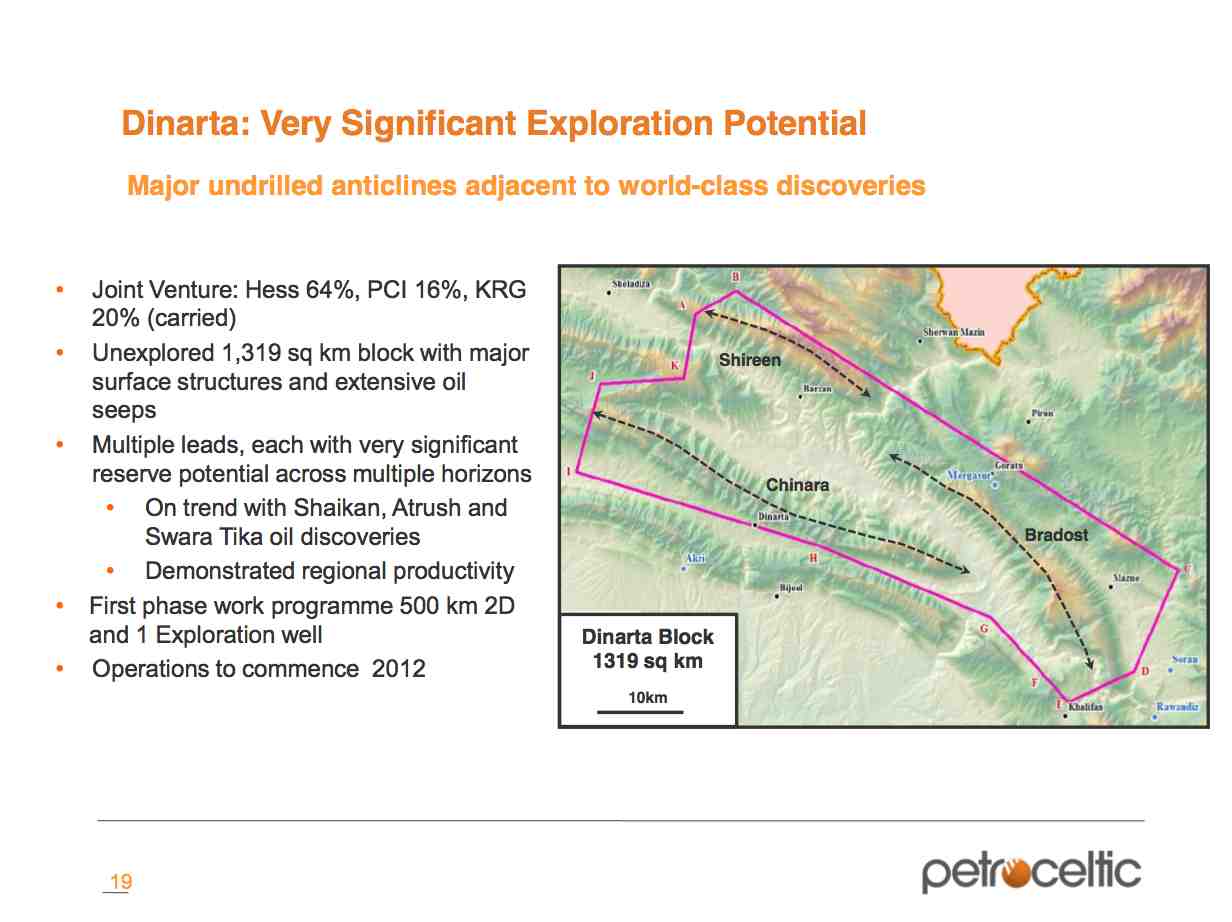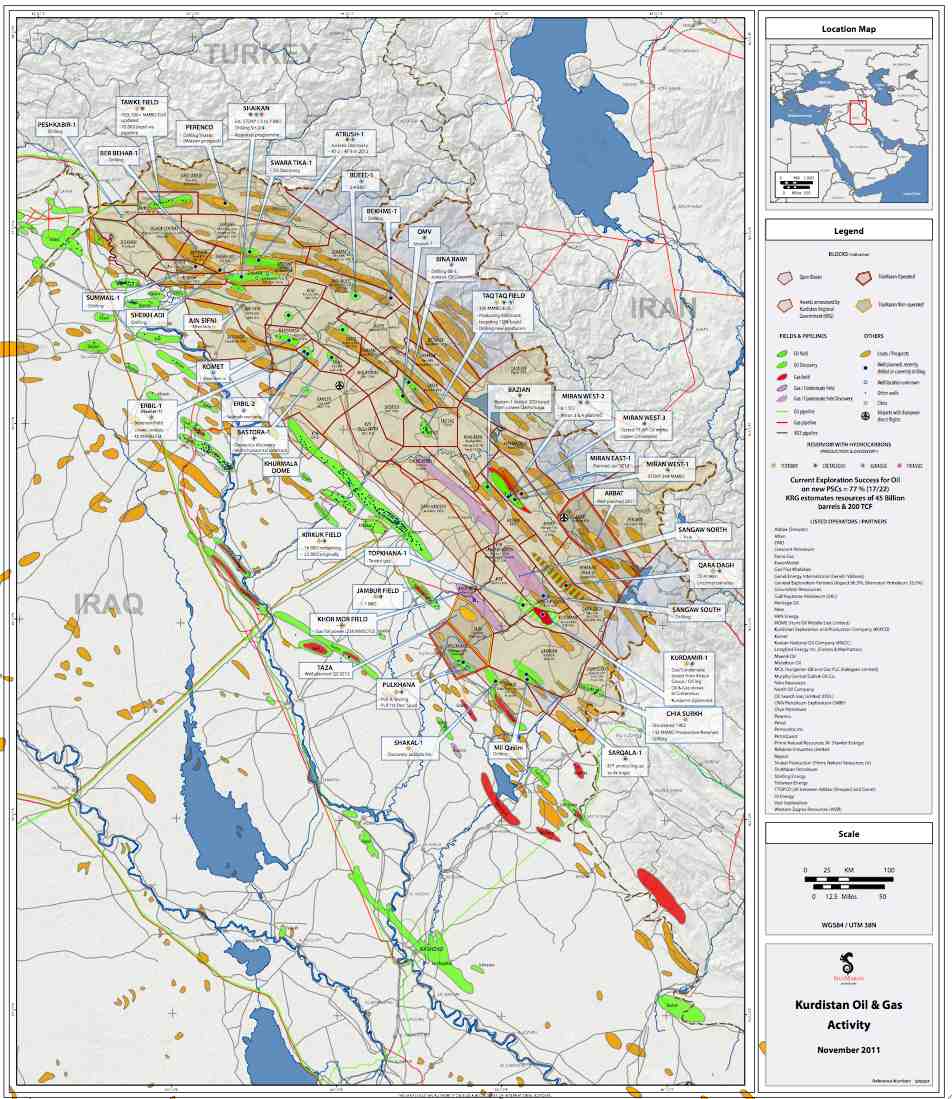January 10th, 2012
Via The Oil Drum, a look at the oil potential of Iraqi Kurdistan:
Whilst much of Iraq may be viewed as in a metastable social and political state, the semi autonomous northern region of Kurdistan has enjoyed relative peace for a number of years. This has enabled the regional government to develop oil exploitation laws and to lease much of the land to foreign exploration and production companies.
Regional operator Gulf Keystone Petroleum has been involved in the discovery of the Shaikan Field, believed to hold between 8 and 13.4 billion barrels in place with appraisal of this giant (potential supergiant) ongoing. Gulf Keystone Petroleum believes that Iraqi Kurdistan may hold 45 billion barrels of oil reserves (recoverable?) lending some credibility to Iraqi claims of 115 billion barrels reserves for the whole country. This compares with a total of 53 billion barrels of oil produced from the North Sea up to the end of 2010.

Figure 1 The Kurdistan semi autonomous region lies between Iraq (yellow), Turkey, and Iran (pink). The area is divided into oil exploration and production licence blocks numbered 1 to 46. The Kurdish people actually lay claim to a substantially larger area that extends beyond these borders into Iraq, Iran and Turkey and this may give rise to ongoing sectarian tension in the recently peaceful region. Slide from Gulf Keystone Petroleum presentation dated October 2011 (large pdf). Disclaimer The author has recently purchased stock in Gulf Keystone Petroleum and Petroceltic whose company presentational materials provide the backbone of this post. Readers need to be aware that information contained in corporate presentations is not necessarily reliable, although companies listed on the London Stock Exchange are regulated and need to be cautious about what they say. For example, Gulf Keystone’s reports on reserves on the Shaikan Field have been audited independently by oil and gas field auditors Ryder Scott and Dynamic Global Advisors.
During a recent review of the activities of small oil companies listed on the London Stock Exchange, I came across some interesting presentations on the oil exploration activity and potential of Kurdistan in northern Iraq. Everyone will know that Iraq has been in a state of unrest since the US led invasion of 2003 that has just recently come to an end. But in the North, the semi autonomous region of Kurdistan has been much more peaceful. Elections were held in 2005 and again, four years later, in 2009. The Kurdistan Regional Government has proceeded to divide the territory into license blocks, many of which have subsequently been leased to foreign oil exploration companies (Figure 1). The oil rights of the Kurdistan semi-autonomous region have not been recognised by the Iraqi government and operating in this area therefore carries significant political risk. Most of the blocks have been leased to small companies and until recently the oil majors have been shy of taking risks in Kurdistan that may compromise their relationship with the Iraqi government.
Geological setting
Kurdistan forms part of the Zagros Fold Belt that is a prolific oil province in Iran and Iraq to the south and west (Figure 2).

Figure 2 Map showing the oil and gas fields of the Zagros fold belt in Iran and Iraq. The Kurdistan area lies to the east of the supergiant Kirkuk field. Map from Greg Croft. The reservoirs are of Triassic and Jurassic age and are deposited along the margin of the paleo Tethys Ocean, which closed owing to large scale plate tectonic movements during the Cretaceous and Tertiary, giving rise to the Alpine – Himalayan mountain belt. In the Zagros Fold belt, the deformation of strata is less severe and is characterised by gentle synclines and anticlines. Source rocks are depressed and warmed in the synclines and the oil formed may migrate up-dip to be trapped in the adjacent anticlines (Figures 3, 4 and 5).
Figure 3 Seismic image of anticline left and satellite image of surface anticline with 4 way dip closure right. Slide from Gulf Keystone Petroleum 
Figure 4 Photograph of large surface anticline. It is rare to find a large oil province where the geology is so vividly expressed on the surface. Exploration companies should actually be able to map and drill these prospects without the aid of seismic data. Slide from Petroceltic presentation (large pdf) dated Dec 2011. Petroceltic have 20% gross interest in blocks 12 and 22. 
Figure 5 Three massive prospects to drill in the Dinarta block. Slide from Petroceltic presentation (large pdf) dated Dec 2011. Exploration history
An interesting slide from Irish independent minnow Petroceltic shows the exploration status in 2007 and 2011 (Figure 6). During the Saddam era, it appears that exploring for oil in Kurdish areas did not take place at all. The Kurdistan semi-autonomous region therefore represents virgin territory bang slap in the middle of one of the most prospective oil exploration territories on Earth. Licensing and drilling has only taken off since 2007 and activity is moving at an amazing pace with several major discoveries already made. ExxonMobil was the first supermajor oil company to accept the political risk with the award of 6 blocks in 2011. A total of 6 blocks remain unlicensed.

Figure 6 Comparing the status in 2007 with 2011 shows an amazing pace of exploration development and discoveries. There are indications that the southeastern end of the area is more gas prone and this will present separate export / sales challenges. Slide from Petroceltic presentation (large pdf) dated Dec 2011. High resolution map of discoveries and prospects in Kurdistan (large pdf). 
Oil export options
Getting the oil out of this landlocked territory surrounded by countries with unstable tendencies presents a major challenge. There is an existing pipeline route called the Kirkuk – Ceyhan pipeline that exports oil through Turkey to the Mediterranean coast (Figure 7). This pipeline crosses the Iraq – Turkey border within Kurd held territory giving them some control over access. There are in fact two pipelines with combined capacity of 1.6 mmbpd which have been the subject of repeated sabotage attacks. They are clearly exposed and difficult to guard (Figure 8). This export route is reported to currently carry around 0.5 mmbpd. There will be competition for access and ownership rights between Kurdistan and Iraq.

Figure 7 The route of the Kirkuk – Ceyhan pipeline. 
Figure 8 The Kirkuk-Ceyhan pipeline is not easily guarded from sabotage. A very recent development (14 Nov 2011) is the announcement that Vallares PLC, established by Nathaniel Rothschild and headed up by ex BP CEO Tony Hayward will merge with Genel Enerji AS and plan to build a new 400,000 bpd pipeline across Turkey to the Mediterranean. Both Genel and Vallares hold acreage in Kurdistan.Concluding thoughts
While it is the early days, given the exploration success so far and the world class pedigree of this petroleum system, the estimate of 45 billion barrels reserves made by Gulf Keystone Petroleum does not seem unreasonable. It is reasonable to speculate that given peace, Kurdistan may export between 2 and 4 million barrels of oil per day within the next decade. With a population of 4 million, Kurdistan could expect to become wealthy like Norway and the Gulf emirates. That is if restless neighbors permit this to happen.
There are a growing number of new, very large, more or less conventional oil plays being discovered that include the sub-salt off Brazil, the Aldous Major – Avaldsnes field in Norway and most recently the news that sub-salt oil has been discovered by Maersk Oil in their first well off Angola. Combined, these vast discoveries promise to make the decline on the downside of Hubbert’s peak a much more gradual affair, for a while at least.
Focusing primarily on The New Seven Sisters - the largely state owned petroleum companies from the emerging world that have become key players in the oil & gas industry as identified by Carola Hoyos, Chief Energy Correspondent for The Financial Times - but spanning other nascent opportunities around the globe that may hold potential in the years ahead, Wildcats & Black Sheep is a place for the adventurous to contemplate & evaluate the emerging markets of tomorrow.
